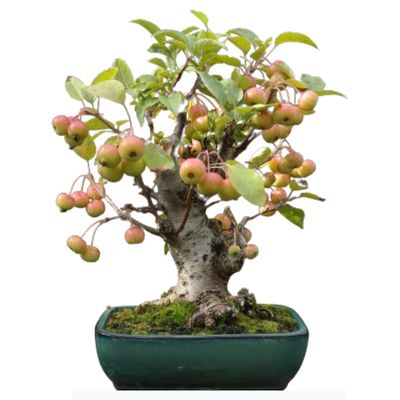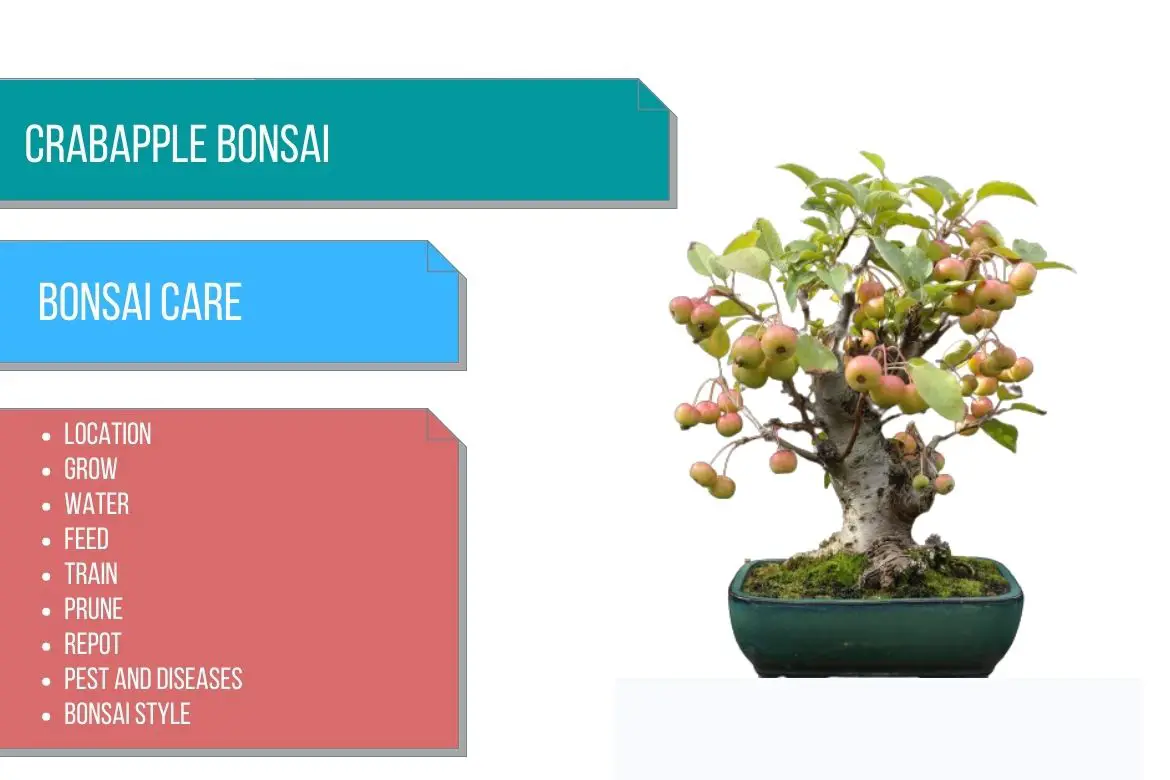
Crab apple
(Malus Spp.)
Country of Origin : Japan
Bonsai Styles : Informal upright, slanting, semi-cascade, twin trunk, clump
Zone : 3 – 8
Crab apple trees are primarily grown as ornamental trees.
Crab apple bonsai tree blooms profusely in spring, which is its main attraction. In fact, there can be so many flowers on trees that the trunk and foliage can easily become obscured by the flowers.
The colors of the flowers vary depending on the variety of the tree. The color can range from deep cerise to pink to white.
The tree also produces small colorful fruits in the fall which are generally unpalatable.
Varieties of crab apple that can be used to make bonsai
It is quite possible to find hundreds of varieties of crab apple. However, some of the crab apple varieties which can be used to make bonsai are:
- Malus halliana : Also known as ‘Hall’s crab apple‘, the leaves of this deciduous tree are narrow and dark glossy green. It has pink flowers and purple colored small fruit. However, it rarely produces fruit when grown in bonsai pot.
- Malus ‘Golden hornet’ : Also known as ‘Golden hornet crab apple‘, this tree produces yellow fruits and white flowers. The fruits remain on the tree even after the leaves are dropped from the tree.
- Malus sylvestris : Also known as ‘Common crab apple‘, this tree is deciduous and has toothed, oval leaves. It produces white flowers tinged with pink color and produces red and yellowish-green fruit.
- Malus ‘Red jade’ : Also known as ‘Weeping crab apple‘, this tree has bright green leaves. The flowers of the tree are pink and white. In the winter, the tree is laden with small, red fruits.
- Malus cerasifera : Also known as ‘Nagasaki crab apple‘, this tree produces pink flower buds that turn into white colored flowers. This is followed by tree bearing cherry colored red fruits.
- Malus sieboldii : Also known as ‘Siebold’s crab apple or Toringo crab apple‘, produces white flowers from its small pink flower buds. The color of the fruits is red or yellow.
- Malus ‘Profusion’ : Also known as ‘Purple crab apple‘, this tree has purple leaves. It produces dark red fruits that are followed by wire-red flowers.
- Malus baccata : Also known as ‘Siberian crab apple‘, this tree has elliptic or egg-shaped green leaves, white flowers and red fruits.
- Malus floribunda : Also known as ‘Japanese flowering crab apple‘, this tree produces pink flower buds which turn into white flowers. It has yellow or red colored fruits. It has mid-green, toothed leaves.
- Malus x micromalus : Also known as ‘Kaido crab apple or Makino crab apple‘, has dark pink buds that open to reveal pink and white flowers. Fruits are red or yellow and about cherry-sized.
There are a few bonsai styles that are incompatible with malus, including windswept, driftwood, forest and literati.
Best location to keep crab apple Bonsai
Sunlight is essential to crab apple bonsai tree growth, and they perform less well if they are grown in the shade. Hence, keep the bonsai tree in full sun all year long.
An ideal temperature range to keep your crabapple bonsai tree is 20 to 80°F (-6 to 26°C). However, protect roots from frost if you are growing them in a shallow bonsai container also if it is a small bonsai tree.
Large bonsai can withstand heavy freezing for a long period, but smaller bonsai may be more susceptible.
You can bring the bonsai tree indoors in spring for a day (in case you can not resist the temptation of admiring its beauty), however move it back to outside settings in the night.
Low light levels combined with warm weather results in sappy, elongated growth, so maintain cool conditions through the winter and early spring when the day length is short.
A constant exposure of the bonsai tree to temperatures exceeding 86°F will induce stress in the tree. But it is likely that the tree wont die.
Refer sunlight requirements for indoor plants for more indoor gardening ideas. Also, refer to do bonsai trees need sunlight for more indoor and outdoor bonsai location ideas.
Propagation of crab apple
Crab apple trees can be propagated by sowing seeds in late fall.
In most cases, these trees are propagated using grafting.
They can also be propagated by air layering in early-summer or spring.
Watering crab apple Bonsai
Throughout the growing season, water your bonsai tree daily.
If you do not give the plant enough water during fruiting, the apples will shrink and fall.
During the winter, keep the bonsai soil evenly moist.
Fresh water should be sprayed on foliage and flowers regularly.
Wiring crab apple Bonsai
Wiring crab apple bonsai tree can be done in between spring and fall.
Use raffia or guy wire to prevent your tree from developing wire marks.
Pruning crab apple Bonsai
When to prune crabapple bonsai?
How to prune crabapple bonsai?
Crab apple bonsai tree branches and long shoots can be pruned in fall.
New shoots should be pruned in mid to late summer. By this time new shoots have formed. Prune the shoots back to two to three leaves or nodes.
In late spring, after flowering, cut back all last year’s non-flowering shoots to a short stub.
Pinching crab apple Bonsai
Pinch new shoots to one or two leaves after flowering in spring, then allow the plant to grow without interruption. This is done to avoid any accidental pinching of next year’s flower buds which are formed in mid summer.
Early in the summer, avoid pinching. This will result in vegetative growth instead of flowering.
You should only pinch the tips of any overextended shoots that emerged from pruning in the late summer.
By pinching out the growing tips of the lateral (secondary) shoots, the energy of the plant will be directed into flower bud development and keep the bonsai style looking trim.
Repotting crab apple Bonsai
When to repot crabapple bonsai?
In early spring, repot a crab apple bonsai tree every two years, before bud burst.
While repotting the tree, use a bonsai container that is deep. A deep pot will help in conservation of moisture and insulation of roots.
You can use a basic bonsai soil mix as a potting soil. Or even a multipurpose compost which is free draining.
OR
You can also use a soil mix consisting of 30% grit and 70% organic matter.
OR
A clay based loam mixed with equal parts of sharp sand.
Must Read: Bonsai Soil Recipes
Must read : Choosing the right bonsai container
Feeding crab apple Bonsai
Balanced feeds should be applied in spring after the flowering stage.
Apply low nitrogen feed in late summer. This will encourage flower buds.
Apply nitrogen free feed in fall.
Fertilizing right after flowering will result in the dropping of the newly set fruit. So avoid that.
When fruit begins to form, stop feeding, and do not resume feeding until fruits are fully developed. This will prevent the triggering of leafy growth instead of producing a good crop of fruits.
Read more about bonsai fertilizer and its application.
Diseases and pest of crab apple Bonsai
The most common problems of crabapple bonsai tree are aphids and mildew. Remove the aphids manually or apply an insecticide.
Increase the ventilation of the tree by placing it in an open area. This can prevent mildew.
Apple canker and rust may also appear. Cut away the infected areas completely and spray with a fungicide.
Crab apple bonsai care
The crab apple is generally easy to maintain, but it does prefer moist soil and plenty of nutrients along with a deeper pot. A crabapple tree that does not receive enough nutrition may lose its branches after flowering or even die.
Crab apples are incredibly hardy, and can withstand weeks of sub-zero temperatures, but the roots of smaller bonsai need protection to some extent in order to be safe.
If the tree is brought into a frost-free, unheated room or greenhouse during the winter, it will flower early, however you should not do this every year since the extended growing period will exhaust the bonsai tree.
The Malus bonsai tree can be brought inside for short periods, but cannot remain inside permanently.
What to look for when buying crab apple Bonsai
Buying flowering bonsai while they are in bloom is not always the best time. It is possible for an unhealthy plant to flower well, but then die back.
A better time to buy a crabapple bonsai tree is during midsummer. At this time, it is easier to evaluate the health of the tree.
Look for a bonsai specimen with a healthy and strong trunk.
Also, look for the presence of many small forks in the branches. These indicate the presence of flowering spurs.

